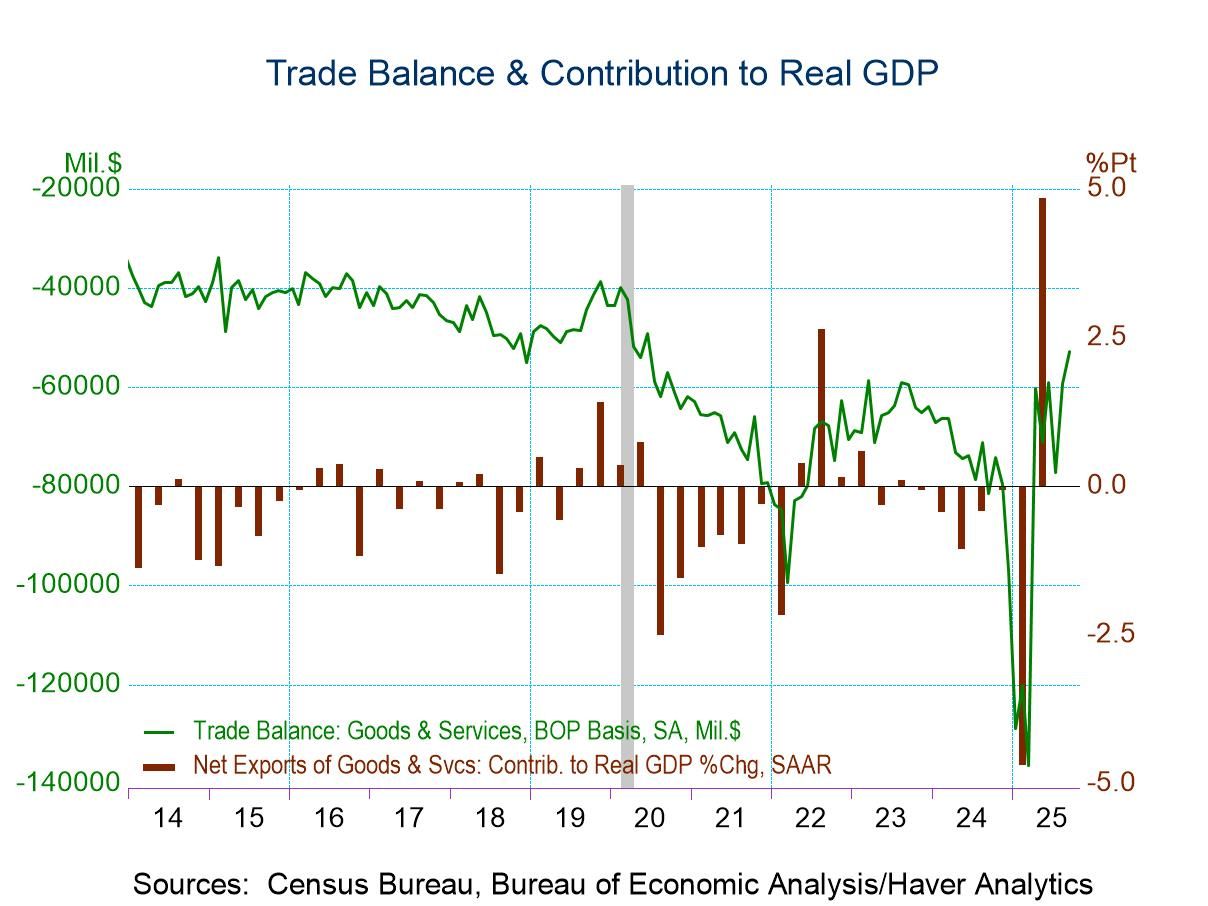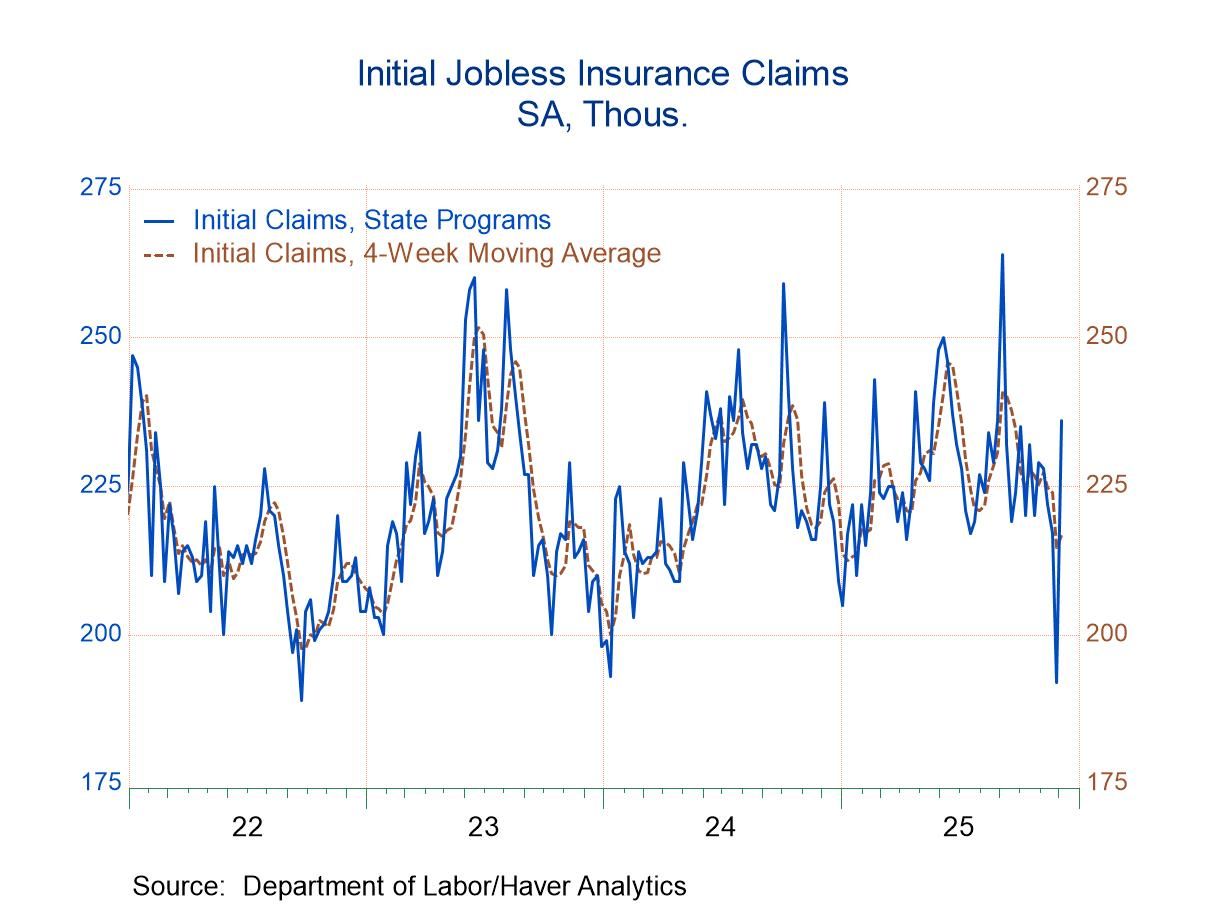U.S. GDP Q1’25 Decline Is Lessened; Price Strength Unrevised but Profits Decline
by:Tom Moeller
|in:Economy in Brief
Summary
- First GDP decline in three years is minimally changed.
- Substantial foreign trade subtraction ahead of tariffs is increased; inventory addition is raised.
- Domestic final demand growth is reduced.
- Price index strength is unchanged, but corporate profits decline.


Real GDP slipped 0.2% SAAR (+2.1% y/y) during the first quarter of 2025, revised from down 0.3%, after increasing 2.4% in Q4’24 and 3.1% in Q3’24. A 0.4% decline had been expected in the Action Economics Forecast Survey. It remained the first decline since Q1 2022.
Foreign trade subtracted 4.90 percentage points from growth last quarter, revised from -4.83 percentage points. Imports surged 42.6% (13.6% y/y) ahead of tariffs, revised from 41.3% which began to take effect late in the quarter. Imports declined 1.9% in Q4’24. Exports rose 2.4% (3.1% y/y), revised from 1.8%, after easing 0.2% in Q4. Inventories added 2.64 percentage points to growth, revised from 2.25 points, after subtracting 0.84 percentage point from Q4 growth.
Real final sales to domestic purchasers grew 2.0% (2.8% y/y), revised from 2.3%, in Q1 after rising 3.0% in Q4. Personal consumption expenditures rose 1.2% (2.9% y/y), revised from 1.8%, following a 4.0% gain. Durable goods spending fell a little-revised 3.8% (+5.2% y/y) after surging 12.4% in Q4. Motor vehicle purchases declined 11.2% (+5.4% y/y) after strengthening 19.7% in Q4. Spending on home furnishings & appliances gained 1.4% (6.1% y/y) following a 5.4% rise. Recreational goods & vehicle outlays improved 0.2% (6.4% y/y) last quarter, revised from 2.5%, after a 13.9% Q4 increase.
Nondurable goods outlays rose 2.2% (2.9% y/y), revised from 2.7%, following 3.1% growth in Q4. Apparel spending increased 6.8% (2.6% y/y) following a 5.0% rise. Food & beverage buying gained 1.1% (2.0% y/y, revised from 2.5%, after a 1.8% increase. Gasoline & fuel oil purchases strengthened 4.5% (3.3% y/y) after falling 2.0% in Q4.
Spending on services increased 1.7% (2.6% y/y), revised from 2.4%, after a 3.0% gain. Outlays on housing & utilities increased 3.0% (1.7% y/y) after rising 1.1% in Q4. Health care expenditures rose 3.2% (4.6% y/y), revised from 4.0%, following a 4.7% strengthening. Transportation outlays increased 5.5% (4.6% y/y) aft1er a 3.7% rise while recreation spending rose 1.4% (2.0% y/y), revised from 4.7%, following a 4.5% rise. Restaurant & hotel expenditures declined 0.9% (+0.8% y/y), revised from +2.1%, after rising 2.8%. Financial services expenditures rose 0.8% (1.8% y/y), revised from 1.9%, after a 3.1% Q4 increase.
Revised higher, business fixed investment increased 10.4% (3.7% y/y), revised from 9.8%, following a 3.0% decline in Q4. Expenditures on structures declined 1.5% (-0.9% y/y), revised from a 0.4% gain, after a 2.9% increase. Expenditures on producers’ durable equipment jumped 24.7% (8.5% y/y), revised from 22.5%, after falling 8.7% in Q4. Outlays on information processing equipment soared 72.9% (19.5% y/y), revised from 69.3%, following a 7.3% decline. Industrial equipment investment rose 4.8% (1.3% y/y), revised from a 1.4% decline, after easing 0.9%. Intellectual property product spending rose 4.6% (2.0% y/y) following a 0.5% decline.
Residential structures investment declined 0.6% (also -0.6% y/y), revised from a 1.3% increase, after a 5.5% Q4 rise.


Government spending fell 0.7% (+2.6% y/y), revised from down 1.5% after a 3.1% Q4 rise. Federal government expenditures declined 4.6% (+3.0% y/y), revised from a 5.1% gain, after rising 4.0% in Q4. National defense expenditures declined 7.1% (+4.2% y/y), revised from 8.0%, after increasing 4.8% in Q4. State & local government spending rose 1.7% (2.4% y/y), revised from 0.8%, following a 2.5% rise.
The GDP chain price index rose an unrevised 3.7% (2.6% y/y) after increasing 2.3% in Q4. It was the largest increase since Q4’22. A 3.7% increase had been expected. The PCE chain price index increased 3.6% (2.5% y/y) following a 2.4% rise. The PCE price index excluding food and energy rose 3.4% (2.8% y/y) after increasing 2.6% in Q4. The business fixed investment price index rose 0.5% (1.8% y/y) after a 1.5% rise. The residential price index strengthened 4.1% (3.2% y/y) after a 1.9% rise while the government price index increased 4.6% (2.8% y/y) following a 2.1% rise. Each of these figures were minimally changed or unrevised.
After-tax corporate profits fell 1.0% (+8.4% y/y) following a 6.7% Q4’24 increase. Before-tax profits declined 2.9% (+5.5% y/y) after a 5.4% rise in Q4. Financial sector profits rose 1.3% (20.5% y/y) after increasing 10.7%. Nonfinancial corporate profits weakened 3.5% (+3.5% y/y) following a 2.0% gain. Profits from the rest of world declined 5.9% (-2.0% y/y) after an 18.8% increase.
The GDP data can be found in Haver’s USECON and USNA databases. USNA contains virtually all of the Bureau of Economic Analysis detail in the national accounts. The Action Economics consensus estimates can be found in AS1REPNA.


Tom Moeller
AuthorMore in Author Profile »Prior to joining Haver Analytics in 2000, Mr. Moeller worked as the Economist at Chancellor Capital Management from 1985 to 1999. There, he developed comprehensive economic forecasts and interpreted economic data for equity and fixed income portfolio managers. Also at Chancellor, Mr. Moeller worked as an equity analyst and was responsible for researching and rating companies in the economically sensitive automobile and housing industries for investment in Chancellor’s equity portfolio. Prior to joining Chancellor, Mr. Moeller was an Economist at Citibank from 1979 to 1984. He also analyzed pricing behavior in the metals industry for the Council on Wage and Price Stability in Washington, D.C. In 1999, Mr. Moeller received the award for most accurate forecast from the Forecasters' Club of New York. From 1990 to 1992 he was President of the New York Association for Business Economists. Mr. Moeller earned an M.B.A. in Finance from Fordham University, where he graduated in 1987. He holds a Bachelor of Arts in Economics from George Washington University.





 Global
Global
